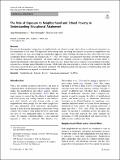Files in this item
The role of exposure to neighborhood and school poverty in understanding educational attainment
Item metadata
| dc.contributor.author | Nieuwenhuis, Jaap | |
| dc.contributor.author | Kleinepier, Tom | |
| dc.contributor.author | van Ham, Maarten | |
| dc.date.accessioned | 2021-04-08T12:30:06Z | |
| dc.date.available | 2021-04-08T12:30:06Z | |
| dc.date.issued | 2021-04-07 | |
| dc.identifier | 273660739 | |
| dc.identifier | 55ff76d3-8a66-4954-9eac-dad1d33cca2f | |
| dc.identifier | 85103911801 | |
| dc.identifier.citation | Nieuwenhuis , J , Kleinepier , T & van Ham , M 2021 , ' The role of exposure to neighborhood and school poverty in understanding educational attainment ' , Journal of Youth and Adolescence , vol. First Online . https://doi.org/10.1007/s10964-021-01427-x | en |
| dc.identifier.issn | 0047-2891 | |
| dc.identifier.other | ORCID: /0000-0002-2106-0702/work/92019853 | |
| dc.identifier.uri | https://hdl.handle.net/10023/22989 | |
| dc.description | This research was specifically funded by the European Research Council under the European Union's Seventh Framework Programme (FP/2007-2013) / ERC Grant Agreement n. 615159 (ERC Consolidator Grant DEPRIVEDHOODS, Socio-spatial inequality, deprived neighbourhoods, and neighbourhood effects). | en |
| dc.description.abstract | Because the demographic composition of neighborhoods and schools overlaps, their effects on educational attainment are not independent of each other. Throughout the early teenage years, the timing and duration of exposure to neighborhood and school contexts can vary, advocating for a longitudinal approach when studying schooling outcomes. This study uses Avon Longitudinal Study of Parents and Children data (N = 4502; 49% female) to examine how exposure to poverty between ages 10–16 predicts educational attainment. The results indicate that enduring exposure to neighborhood poverty relates to educational attainment, while timing does not. For school poverty, longer exposure is related to lower attainment, but earlier exposure has a stronger impact than later exposure. Adolescents who were exposed to poverty in both contexts for the full observation period had the lowest educational attainment. The findings highlight the importance of understanding when and how long adolescents are exposed to contextual poverty. | |
| dc.format.extent | 21 | |
| dc.format.extent | 822103 | |
| dc.language.iso | eng | |
| dc.relation.ispartof | Journal of Youth and Adolescence | en |
| dc.subject | Neighborhoods | en |
| dc.subject | Schools | en |
| dc.subject | Poverty | en |
| dc.subject | Educational attainment | en |
| dc.subject | ALSPAC | en |
| dc.subject | G Geography (General) | en |
| dc.subject | H Social Sciences (General) | en |
| dc.subject | L Education (General) | en |
| dc.subject | 3rd-DAS | en |
| dc.subject.lcc | G1 | en |
| dc.subject.lcc | H1 | en |
| dc.subject.lcc | L1 | en |
| dc.title | The role of exposure to neighborhood and school poverty in understanding educational attainment | en |
| dc.type | Journal article | en |
| dc.contributor.sponsor | European Research Council | en |
| dc.contributor.institution | University of St Andrews. Population and Health Research | en |
| dc.contributor.institution | University of St Andrews. School of Geography & Sustainable Development | en |
| dc.identifier.doi | 10.1007/s10964-021-01427-x | |
| dc.description.status | Peer reviewed | en |
| dc.identifier.grantnumber | ERC-2013-CoG | en |
This item appears in the following Collection(s)
Items in the St Andrews Research Repository are protected by copyright, with all rights reserved, unless otherwise indicated.

